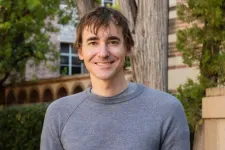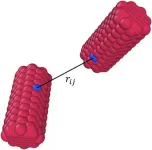(Press-News.org) BOZEMAN – Scientists at Montana State University have been studying unique immune systems for decades, and a research team in the Department of Microbiology and Cell Biology took another step forward with work described in a paper published in the highly regarded journal Nature.
The Aug. 7 paper, titled “A virally-encoded tRNA neutralizes the PARIS antiviral defense system,” was fast-tracked for publication by the journal due to the importance of the findings. MSU doctoral student Nate Burman is the lead author, along with professor Blake Wiedenheft, six other MSU scientists and collaborators from France, Russia and Sweden.
The research explores the PARIS immune system, which bacteria use to protect themselves against viral infections. Work with PARIS, which stands for Phage Anti-Restriction Induced System, builds on Wiedenheft’s ongoing research into CRISPR, or Clustered Regularly Interspaced Short Palindromic Repeats, a field in which Wiedenheft is an internationally leading scientist.
“In nature, CRISPRs are part of a family of adaptive immune systems in bacteria, but scientists have repurposed these immune systems as programmable molecular scalpels that are now being used to repair damaged DNA for lifesaving therapies,” said Burman, who is beginning the third year of his doctoral studies. “But CRISPRs aren’t the only bacterial immune systems that exist. What’s unique about PARIS is that it recognizes viral proteins instead of nucleic acid. That’s similar to how a human immune response works. PARIS is totally different from a human immune system, but the conceptual analogy is intriguing.”
One of the crucial new findings in the paper is the first complete image of what the PARIS system looks like. To generate that image, Burman used a unique, ultra-high-powered microscope housed at MSU. It is equipment that few campuses nationwide have access to, housed in MSU’s Cryo-EM Core Facility, and MSU was only the second university in the region to acquire one back in 2021.
“Using a new state-of-the-art cryo-electron microscope at MSU, Nate was able to ‘see’ the PARIS complex that forms inside of a bacterial cell,” said Wiedenheft. “It's wild to think that we can now peer into cells and see the machines that do the work necessary to maintain life or defend it from infection.”
The structure of PARIS reveals a propeller-shaped complex that consumes ATP, or energy, in search of invading viral proteins. Foreign protein detection triggers the release of a toxin that shuts down viral replication, protecting healthy cells.
There are numerous PARIS immune systems that operate in different ways, Burman said, and the next steps in this research will include identifying the triggers that activate those systems. Knowing how PARIS recognizes a viral attack and initiates a response could advance understanding of how different types of immunity provide protection, including in organisms beyond bacteria.
As researchers in Wiedenheft’s lab continue to operate on the forefront of structural biology, Burman said the institutional support for their scientific work has fostered a collaborative domain for scientists, regardless of where they are in their career. Burman’s own research experience in Bozeman began when he was an undergraduate student at Carroll College in Helena and participated in a research experience for undergraduates, or REU, at MSU. Now, he relishes the opportunity to be a mentor to the young scientists coming after him.
“Blake’s support is huge, and he really pushes us think big about small proteins, how they work in nature and how we might use them in new ways,” Burman said.
END
Montana State scientists publish bacterial immune research in Nature
The paper highlights new insights into the PARIS, an immune system that bacteria use to respond to viral infections
2024-08-27
ELSE PRESS RELEASES FROM THIS DATE:
NIH prize challenge recognizes undergraduate biomedical engineers for innovative medical device designs
2024-08-26
The National Institutes of Health (NIH) and the higher education non-profit VentureWell have selected 11 winners and five honorable mentions in the Design by Biomedical Undergraduate Teams (DEBUT) Challenge, who are set to receive prizes totaling $160,000. The awards will be presented to the winning teams on Oct. 25, 2024, during the annual Biomedical Engineering Society conference in Baltimore.
Now in its 13th year, the annual DEBUT Challenge calls on teams of undergraduate students to identify ...
NJIT and Illinois research on data analytics will measure impact of scientific literature
2024-08-26
Three distinct problems in data science — trend identification in graphs, the quantitative study of scientific literature and evaluation of single-cell genomics — will all be addressed by new research in large-scale network analytics, jointly led by Distinguished Professor David Bader at New Jersey Institute of Technology.
The problems have a common challenge of finding patterns, known as community detection, from inside incredibly large datasets. Work is funded by a $648,000 National Science Foundation grant, Cyber-Infrastructure ...
UCLA receives $1 million NSF grant to accelerate commercialization of quantum technologies
2024-08-26
Researchers from the California NanoSystems Institute at UCLA and their colleagues have received a one-year, $1 million grant as part of a new National Science Foundation program aimed at accelerating the development and commercialization of quantum technologies for the benefit of society.
The Quantum Sensing and Imaging Lab, or Q-SAIL, which will be led by UCLA quantum physicist David Leibrandt, is one of five pilot projects across the country selected by the NSF to participate in the agency’s new National Quantum Virtual Laboratory, a first-of-its-kind national resource to enable the faster ...
3D shapes of viral proteins point to previously unknown roles
2024-08-26
SAN FRANCISCO—Viruses are tricky to keep up with. They evolve quickly and regularly develop new proteins that help them infect their hosts.
These rapid shifts mean that researchers are still trying to understand a multitude of viral proteins and precisely how they increase viruses’ infecting abilities—knowledge that could be crucial for developing new or better virus-fighting treatments.
Now, a team of scientists at Gladstone Institutes and the Innovative Genomics Institute led by Jennifer Doudna, PhD, have harnessed computational tools to predict the three-dimensional shapes of nearly 70,000 viral ...
UVA's first-ever data science majors begin their journey
2024-08-26
A new era at the University of Virginia’s School of Data Science officially kicked off, as the inaugural class of data science undergraduate majors arrived for orientation on the eve of UVA’s first day of classes.
Throughout the day at the new School of Data Science building, students heard from faculty and staff, learned more about their curriculum, took headshots and a group photograph, and began to familiarize themselves with classrooms and other features of the facility that would be their academic home.
The day also served as a call to action, as students learned not only what requirements would be needed to complete their degree but what a data ...
High BMI eligibility for semaglutide could cost Medicare an additional $145 billion annually
2024-08-26
Embargoed for release until 5:00 p.m. ET on 26 August 2024
Annals of Internal Medicine Tip Sheet
@Annalsofim
Below please find summaries of new articles that will be published in the next issue of Annals of Internal Medicine. The summaries are not intended to substitute for the full articles as a source of information. This information is under strict embargo and by taking it into possession, media representatives are committing to the terms of the embargo not only on their own behalf, but also on behalf of the organization they represent.
----------------------------
1. High ...
Brigham-led study estimates 1 in 7 Medicare beneficiaries with high body mass index may qualify for anti-obesity drug
2024-08-26
If Medicare Part D narrowly defines cardiovascular disease, majority of patients would remain ineligible while new federal spending could still exceed $10 billion
Current federal regulation restricts Medicare from covering drugs prescribed solely for weight loss. However, in March 2024, Medicare announced it would extend coverage to semaglutide (Wegovy), a popular glucagon-like peptide-1 receptor agonist (GLP-1RA), for patients with elevated body mass index (BMI) who also had established cardiovascular disease (CVD). This means that the definition of “established CVD,” which has not been ...
$66 million in 10 years: Groundbreaking strategic investment fund to drive biomedical innovation in Australia
2024-08-26
With a grand vision of investing $66 million over 10 years in groundbreaking medical innovations, WEHI’s first strategic investment fund, 66ten, is the largest internal pre-seed and seed fund created by an Australian medical research institute.
Managed by WEHI Ventures, 66ten serves the sole purpose of bridging the gap between scientific discoveries and commercial viability, ultimately creating both positive outcomes for patients and healthcare systems globally as well as financial returns to investors.
Since its foundation a year ago, 66ten has ...
New way to potentially slow cancer growth
2024-08-26
LA JOLLA, CA—Fighting cancer effectively often involves stopping cancer cells from multiplying, which requires understanding proteins that the cells rely on to survive. Protein profiling plays a critical role in this process by helping researchers identify proteins—and their specific parts—that future drugs should target. But when used on their own, past approaches haven’t been detailed enough to spotlight all potential protein targets, leading to some being missed.
Now, by combining two methods of protein analysis, a team of chemists at Scripps Research has mapped more than 300 small molecule-reactive ...
Using machine learning to speed up simulations of irregularly shaped particles
2024-08-26
Simulating particles is a relatively simple task when those particles are spherical. In the real world, however, most particles are not perfect spheres but take on irregular and varying shapes and sizes. Simulating these particles becomes a much more challenging and time-consuming task.
The ability to simulate particles is critical to understanding how they behave. For example, microplastics are a new form of pollution as plastic waste has increased drastically and uncontrollably decays in the environment ...
LAST 30 PRESS RELEASES:
Post-stroke injection protects the brain in preclinical study
Cardiovascular risk score predicts multiple eye diseases
Health: estimated one in ten British adults used or interested in GLP-1 medications for weight loss
Exercise to treat depression yields similar results to therapy
Whooping cough vaccination for pregnant women strengthens babies’ immune system
Dramatic decline in new cases of orphanhood in Uganda driven by HIV treatment and prevention programs
Stopping weight loss drugs linked to weight regain and reversal of heart health markers
Higher intake of food preservatives linked to increased cancer risk
Mass General Brigham–developed cholera vaccine completes phase 1 trial
First experimental validation of a “150-year-old chemical common sense” direct visualization of the molecular structural changes in the ultrafast anthracene [4+4] photocycloaddition reaction
Lack of support for people on weight loss drugs leaves them vulnerable to nutritional deficiencies, say experts
Dogs’ dinners can have greater climate impact than owners’
Are you ready to swap salmon for sprats and sardines?
1.6 million UK adults used weight loss drugs in past year
American College of Cardiology comments on new dietary guidelines for Americans
American Society of Gene & Cell Therapy and Orphan Therapeutics Accelerator partner to advance and commercialize promising rare disease treatments
One in 14 patients having day case surgery have new or worse chronic pain 3 months after their operation
New study highlights link between eviction rates and gun violence
Heatwaves heat up soil but not toxin levels in rice, study finds
Digital modeling reveals where construction carbon emissions really come from
Turning farm waste into water filters
New study shows how the spleen helps the immune system accept a transplant
New Mayo Clinic study advances personalized prostate cancer education with an EHR-integrated AI agent
Researchers identify novel therapeutic target to improve recovery after nerve injury
Microbes in breast milk help populate infant gut microbiomes
Reprogramming immunity to rewrite the story of Type 1 diabetes
New tool narrows the search for ideal material structures
Artificial saliva containing sugarcane protein helps protect the teeth of patients with head and neck cancer
Understanding the role of linear ubiquitination in T-tubule biogenesis
Researchers identify urban atmosphere as primary reservoir of microplastics
[Press-News.org] Montana State scientists publish bacterial immune research in NatureThe paper highlights new insights into the PARIS, an immune system that bacteria use to respond to viral infections





